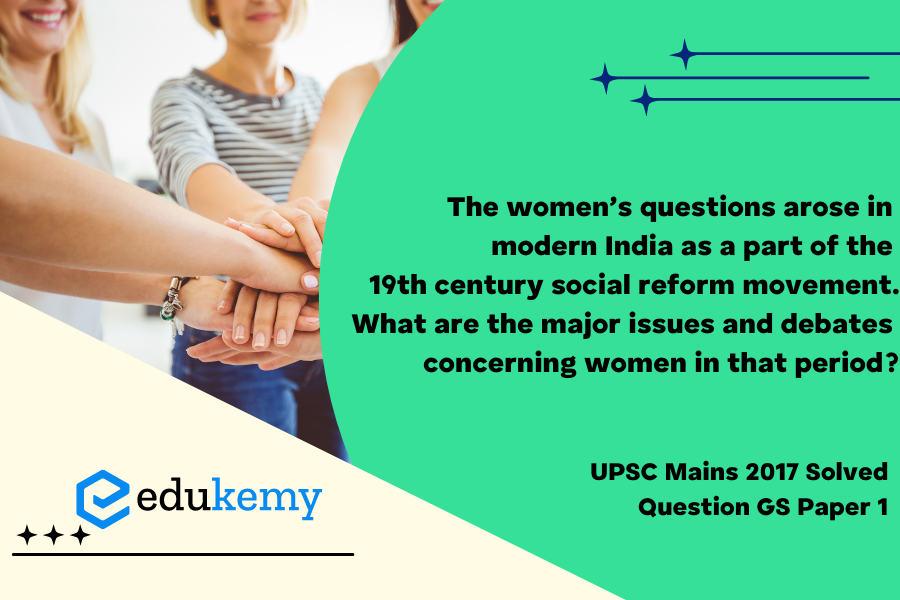The emergence of women’s questions in modern India during the 19th century marked a pivotal juncture in the nation’s socio-cultural landscape, catalyzed by the fervor of the social reform movement. This transformative period was characterized by a myriad of issues and debates that encapsulated the multifaceted challenges faced by women. One of the foremost concerns pertained to the status of women in society, as they grappled with deeply entrenched patriarchal norms and discriminatory practices. The restrictive customs of child marriage, prevalent dowry systems, and the denial of education to women were contentious topics that fueled the discourse. Moreover, the push for women’s rights and empowerment gained momentum, prompting discussions on their role in public life, access to employment opportunities, and the right to suffrage. The reformers of the time, including luminaries like Raja Ram Mohan Roy and Ishwar Chandra Vidyasagar, played a crucial role in challenging regressive norms and advocating for women’s emancipation. Simultaneously, the period witnessed debates on the appropriate balance between tradition and modernity, as differing ideologies clashed in the pursuit of redefining women’s roles in a rapidly changing society. As the 19th-century social reform movement unfolded, the women’s question became a central theme, fostering a nuanced discourse that laid the groundwork for subsequent strides towards gender equality in India.
Tag: Society of India.
Contents
Decoding the Question:
- In Introduction, try to start by writing about the social reform status of women in India.
- In Body,
- Discuss some major issues and debates concerning women in the social reform movement.
- In Conclusion, summarize the answer with a futuristic view..
Answer:
The position of women in India has diversified in different periods and varied classes, religions and ethnic groups. In the 19th century, the problems of women in India invited the attention of Western humanitarian thinkers, Christian missionaries and Indian socio-religious philosophers. It concentrated on improving the status of women, promoting their education, and attacked social practices embedded in social and legal inequalities and religious traditions of various communities.
As India grappled with colonial influences, socio-cultural stagnation, and traditional gender hierarchies, the women’s question emerged as a compelling force for societal reform. Prominent figures like Raja Ram Mohan Roy played an important role in getting the sati system abolished Ishwar Chandra Vidyasagar and Maharishi Karve pleaded for remarriage of widows. Justice Ranade criticized child marriages, polygyny, restrictions on remarriage of widows, and non-access to education.
Major Issues and Debates Concerning Women in the Social Reform Movement:
- Sati: The practice of Sati, where widows were expected to immolate themselves on their husbands’ funeral pyres, was a deeply entrenched social custom. Social reformers, both Indian and British, vehemently opposed this practice and campaigned for its abolition.
The debates centered around cultural relativism, religious freedom, and women’s agency. Reformers like Iswar Chandra Vidyasagar argued that Sati was a violation of human rights, while traditionalists often cited religious justifications.

- Child Marriage: Child marriage was a widespread practice, resulting in early and often harmful marriages for young girls. Reformers advocated for raising the marriageable age and ensuring informed consent. Reformers like Jyotiba Phule argued for girls’ education and the importance of their physical and mental well-being. For Instance- Controlling Child Marriages through legislative reforms like Age of Consent Act, 1891, Sarda Act, 1930.
- Purdah System and Female Education: The purdah system restricted women’s mobility and access to education. Reformers like Savitribai Phule sought to challenge these norms and promote education for women.
- Polygamy and Women’s Property Rights: The practice of polygamy and the lack of property rights for women were contentious issues. Reformers advocated for monogamy and the protection of women’s property rights.
- Social Status and Widowhood: Widows faced social ostracism and were often denied basic rights. Reformers worked to improve the condition of widows and provide them with support and opportunities. Organizations like the Brahmo Samaj, Prarthana Samaj, Arya Samaj etc. advocated for it. For Instance- Vishnu Shastri Pandit founded the Widow Remarriage Association in the 1850s. Karsondas Mulji started the Satya Prakash in Gujarati in 1852 to advocate widow remarriage.
- Participation in Public Life: The question of women’s participation in public life and political activities was a subject of discussion. Reformers Sarojini Naidu argued for women’s involvement in social and political issues. For Instance- In 1910, Sarla Devi Chaudhurani convened the first meeting of the Bharat Stree Mahamandal in Allahabad. It is Considered as the first major Indian women’s organisation set up by a woman.
- Legal Reforms and Social Legislation: Advocacy for legal reforms, including property rights, inheritance laws, and marriage laws, aimed to improve women’s legal status and protection. For Instance- child marriage was banned in 1929, and the legal age of marriage for women was established at 14 years.
To summarize, the issues of women in the 19th century are mainly related to the social upliftment of women in Indian society. Efforts were on to empower women that included social reforms and economic self-reliance.Thus, the Women’s movement during the 19th century was an important variant of social movement because it intended to bring reforms in the institutional arrangements, values, customs and beliefs in the society that had subjugated women over the years.
In case you still have your doubts, contact us on 9811333901.
For UPSC Prelims Resources, Click here
For Daily Updates and Study Material:
Join our Telegram Channel – Edukemy for IAS
- 1. Learn through Videos – here
- 2. Be Exam Ready by Practicing Daily MCQs – here
- 3. Daily Newsletter – Get all your Current Affairs Covered – here
- 4. Mains Answer Writing Practice – here


